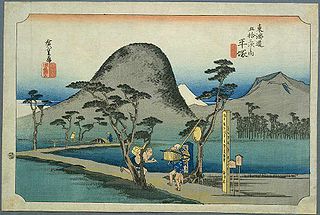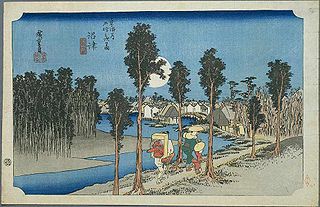
Maisaka was a town located in Hamana District, Shizuoka Prefecture, Japan.

Hodogaya-juku was the fourth of the fifty-three stations of the Tōkaidō. It is located in Hodogaya-ku in the present-day city of Yokohama, Kanagawa Prefecture, Japan. Occasionally, it is also written as 保土ヶ谷宿.

Akasaka-juku was the thirty-sixth of the fifty-three stations of the Tōkaidō. It is located in present-day Toyokawa, Aichi Prefecture, Japan. It was only 1.7 kilometres (1.1 mi) from Goyu-juku, the preceding post station.

Kuwana-juku was the forty-second of the fifty-three stations of the Tōkaidō. It is located in former Ise Province in what is now part of the city of Kuwana, in Mie Prefecture, Japan. It was located on the western shores of the Ibi River and is considered to be the easternmost point of the Kansai dialect. It is 28 km from the preceding post station of Miya-juku.

Shirasuka-juku was the thirty-second of the fifty-three stations of the Tōkaidō. It is located in Kosai, Shizuoka Prefecture, Japan. During the Edo period, it was the westernmost post station of Tōtōmi Province.

Kanaya-juku was the twenty-fourth of the fifty-three stations of the Tōkaidō. It is located in what is now part of Shimada, Shizuoka Prefecture, Japan. During the Edo period, it was the easternmost post station of Tōtōmi Province.

Hamamatsu-juku was the twenty-ninth of the fifty-three stations (shukuba) of the Tōkaidō. It is located in what is now Hamamatsu's Naka-ku in Shizuoka Prefecture, Japan.

Fujisawa-shuku was the sixth of the fifty-three stations of the Tōkaidō. It is located in the present-day city of Fujisawa, Kanagawa Prefecture, Japan.

Ishiyakushi-juku was the forty-fourth of the fifty-three stations of the Tōkaidō. It is located in former Ise Province in what is now part of the city of Suzuka, Mie Prefecture, Japan. It received its name from the nearby Buddhist temple, Ishiyakushi-ji.

Hiratsuka-juku was the seventh of the fifty-three stations (shukuba) of the Tōkaidō. It is located in the present-day city of Hiratsuka, Kanagawa Prefecture, Japan.

Okitsu-juku was the seventeenth of the fifty-three stations of the Tōkaidō. It is located in what is now part of the Shimizu-ku area of Shizuoka, Shizuoka Prefecture, Japan.

Numazu-juku was the twelfth of the fifty-three stations of the Tōkaidō. It is located in the present-day city of Numazu, Shizuoka Prefecture, Japan.

Ejiri-juku was the eighteenth of the fifty-three stations of the Tōkaidō. It is one of four former post stations located in what is now part of the Shimizu-ku area of Shizuoka, Shizuoka Prefecture, Japan. It was 3.4 kilometers from Okitsu-juku, the preceding post station.

Miya-juku was the forty-first of the fifty-three stations of the Tōkaidō. It is located in former Owari Province in what is now part of the Atsuta-ku section of the city of Nagoya, in Aichi Prefecture, Japan. It was six km from Narumi-juku, the preceding post station.

Futagawa-juku was the thirty-third of the fifty-three stations of the Tōkaidō. It is located in what is now the city of Toyohashi, Aichi Prefecture, Japan. It was the eastern most post station in Mikawa Province.

Arai-juku was the thirty-first of the fifty-three stations of the Tōkaidō. It is located in the city of Kosai, Shizuoka Prefecture, Japan. During the Edo period, it was located in Tōtōmi Province. The kanji for the post station were originally also written as 荒江 and 荒井 (Arai).

Yoshida-juku was the thirty-fourth of the fifty-three stations of the Tōkaidō. It is located in the center of what is now the city of Toyohashi, Aichi Prefecture, Japan. It was 287 kilometres (178 mi) from the start of the route in Edo's Nihonbashi and 6.1 kilometres (3.8 mi) from Futagawa-juku to the east and 10.5 kilometres (6.5 mi) from Goyu-shuku to the west.

Narumi-juku was the fortieth of the fifty-three stations of the Tōkaidō. It is located in former Owari Province in what is now part of the Midori-ku section of the city of Nagoya, in Aichi Prefecture, Japan.

Shōno-juku was the forty-fifth of the fifty-three stations of the Tōkaidō. It is located in former Ise Province in what is now part of the city of Suzuka, Mie Prefecture, Japan.

The Arai Barrier is the only surviving security checkpoint of several which were established by the Tokugawa Shogunate on the Tōkaidō highway connecting the capital of Edo with Kyoto in Edo period Japan. Its official name was the Imagiri Barier. In 1921, the site was recognized as a National Historic Site, and in recognition that it had only surviving Edo-period checkpoint structure remaining in the country, its status was upgraded to that of a Special National Historic Site by the Japanese government in 1962.



















